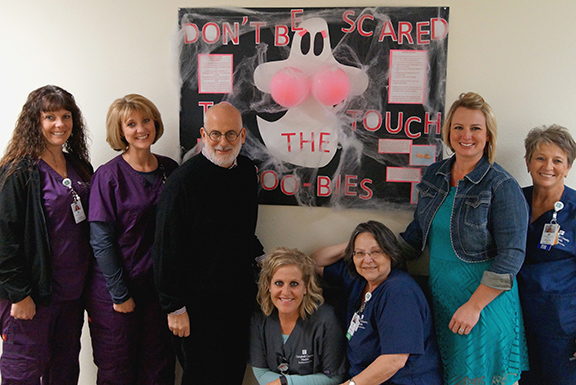Don't be scared to touch the BOOOO-bies
- Posted On:
- Written By: Felicia Messimer

Campbell County Health's Heptner Cancer Center staff got together recently to create a Halloween-focused twist to breast cancer awareness this October!
Leigh Worsley, Heptner Cancer Center's manager, constructed a Don't be Scared to Touch the Booo-bies educational board featuring a curvy ghost and some tidbits focused on breast cancer awareness. The effort is one of many activities that CCH is participating in to help Paint Gillette Pink, a movement supported by the Campbell County Healthcare Foundation’s Cancer Care Committee.
For those who can’t see the board, we’ve included the tidbits for you to read below. However, it’s not too late to help Paint Gillette Pink. Here are a few ways you can show your support:
- You can help “Paint Gillette Pink” by purchasing a window or car decal, or yard sign showing your support. Visit the Paint Gillette Pink Facebook page to order “Paint Gillette Pink” items, www.facebook.com/Paintgillettepink.
- Patronize The Prime Rib Restaurant and Wine Cellar, Old Chicago Gillette, or Buffalo Wild Wings and ‘round-up’ your bill for donation to the Cancer Care Committee.
- Purchase pink athletic gear at Universal Athletic Gillette.
- The Coffee Shoppe at CCMH will also have a pink donation jar, so you can put the change from your cup of coffee to work to help others, or look for Paint Gillette Pink donation jars at gas stations and other businesses around town.
- The Gift Shoppe at CCMH is selling pink ribbon compression socks and other pink ribbon merchandise. (Compression socks are great for those who spend a lot of time on their feet, as they help alleviate tired, achy legs and feet.)
- The first 700 fans at the October 21 Campbell County High School Camel football game will receive a pink rally towel, sponsored by CCH. The Camel players will be decked out in pink socks to show their support.
- And, join us for a PINK Out Day on Friday, October 28 to support efforts to end breast cancer forever!
Be sure to check out last year's blog, October is Breast Cancer Awareness Month, for more information on breast cancer tips.

Breast Cancer Screening Guidelines (taken from the American Cancer Society)
- Women ages 40-44 should have the choice the start annual mammograms if they wish to do so.
- Women ages 45-54 should get mammograms every year.
- Women 55 and older should switch to mammograms every 2 years or can continue yearly screenings.
- Screening should continue as long as the woman is in good health and is expected to live 10 years or longer.
- Some women because of their family history, a genetic tendency, or certain other factors should be screened with MRI’s along with mammograms. Please talk to your health care provider about your risk and the best screening plan for you.
U.S. Breast Cancer Statistics
- About 1 in 8 women (approximately 12%) will develop invasive breast cancer over the course of her lifetime.
- A man’s lifetime risk of breast cancer is approximately 1 in 1,000.
- 93% of women with early-stage breast cancer diagnosis survive beyond 5 years.
- Besides skin cancer, breast cancer is the most commonly diagnosed cancer among American women. In 2016, it’s estimated that just under 30% of newly diagnosed cancers in women will be breast cancers.
- A woman’s risk of breast cancer nearly doubles if she has a first-degree relative (mother, sister, daughter) who has been diagnosed with breast cancer.
- About 85% of breast cancers occur in women who have NO family history of breast cancer.
- The most significant risk factors for breast cancer are gender (being a woman) and age (growing older).
Self Breast Exam steps
First: Begin by looking at your breasts in the mirror with your shoulders straight and your arms on your hips. Here’s what you should look for:
- Breasts that are their usual size, shape & color
- Breasts that are evenly shaped without visible distortion or swelling
- Look for dimpling, puckering or bulging of the skin
- Nipples-look for strange positions or an inverted nipple.
- Look for redness, rash or swelling
Second: Now, raise your arms and look for the same changes as listed above.
Third: While you’re in the mirror, look for any signs of fluid coming out of one or both nipples. This could be a watery, milky, or yellow fluid/blood.
Fourth: Next, feel your breasts while lying down. Using your right hand to feel your left breast and then your left to feel your right breast. Use a firm, smooth touch with the first few finger pads of your hand, keeping the fingers flat and together. Use a circular motion, about the size of a quarter. Cover the entire breast from top to bottom, side to side-from your collarbone to the top of your abdomen. And from your armpit to your cleavage.
Finally: Feel your breasts while you are standing or sitting. Many women find it easier to feel their breasts when they are wet and slippery, so they like to do this in the shower. Cover your entire breast, using the same hand movements as described above.
